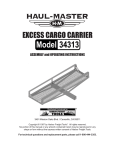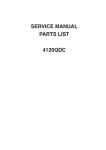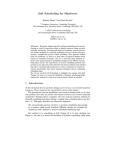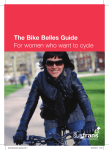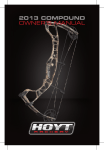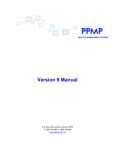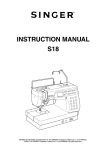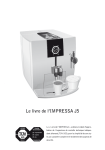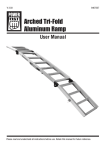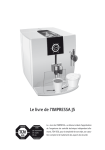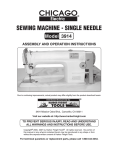Download Singer S16 User's Manual
Transcript
INSTRUCTION MANUAL S16 SINGER and STUDIO are trademarks of The Singer Company Limited S.à.r.l. or its Affiliates. ©2014 The Singer Company Limited S.à.r.l. or its Affiliates. All rights reserved. IMPORTANT SAFETY INSTRUCTIONS When using an electrical appliance, basic safety precautions should always be followed, including the following: This sewing machine is designed and manufactured for household use only. Read all instructions before using this sewing machine. DANGER— To reduce the risk of electric shock: 1. An appliance should never be left unattended when plugged in. Always unplug this sewing machine from the electric outlet immediately after using and before cleaning. WARNING— To reduce the risk of burns, fire, electric shock, or injury to persons: 1. 2. 3. 4. 5. 6. 7. Do not allow to be used as a toy. Close attention is necessary when this sewing machine is used by or near children. Use this appliance only for its intended use as described in this owner’s manual. Use only attachments recommended by the manufacturer as contained in this owner’s manual. Never operate this sewing machine if it has a damaged cord or plug, if it is not working properly, if it has been dropped or damaged, or dropped into water. Return this sewing machine to the nearest authorized dealer or service center for examination, repair, electrical or mechanical adjustment. Never operate the appliance with any air opening blocked. Keep ventilation openings of this sewing machine and foot controller free from accumulation of lint, dust and loose cloth. Never drop or insert any object into any opening. Do not use outdoors. Do not operate where aerosol (spray) products are being used or where oxygen is being administered. 8. To disconnect, turn all controls to the off (“O”) position, then remove plug from outlet. 9. Do not unplug by pulling on cord. To unplug, grasp the plug, not the cord. 10. Keep fingers away from all moving parts. Special care is required around the sewing machine needle and/or cutting blade. 11. Always use the proper needle plate. The wrong plate can cause the needle to break. 12. Do not use bent needles. 13. Do not pull or push fabric while stitching. It may deflect the needle causing it to break. 14. Switch this sewing machine off (“O”) when making any adjustment in the needle area, such as threading the needle, changing the needle, threading the bobbin or changing the presser foot, and the like. 15. Always unplug this sewing machine from the electrical outlet when removing covers, lubricating, or when making any other adjustments mentioned in this owner’s manual. SAVE THESE INSTRUCTIONS For Europe only: This appliance can be used by children aged from 8 years and above and persons with reduced physical, sensory or mental capabilities or lack of experience and knowledge if they have been given supervision or instruction concerning use of the appliance in a safe way and understand the hazards involved. Children shall not play with the appliance. Cleaning and user maintenance shall not be made by children without supervision. For outside Europe (except U.S.A and Canada): This appliance is not intended for use by persons (including children) with reduced physical, sensory or mental capabilities, or lack of experience and knowledge, unless they have been given supervision or instruction concerning use of the appliance by a person responsible for their safety. Children should be supervised to ensure that they do not play with the appliance. Please note that on disposal, this product must be safely recycled in accordance with relevant National legislation relating to electrical/electronic products. If in doubt please contact your retailer for guidance. (European Union only) 2 TABLE OF CONTENTS MACHINE IDENTIFICATION OF PARTS Machine Identification .................................................................................................................... 4 Standard Accessories.................................................................................................................... 5 Attaching Knee Lifter...................................................................................................................... 5 GETTING READY TO SEW Connecting Machine to Power Supply............................................................................................ 6 Controlling Sewing Speed.............................................................................................................. 6 Up/Down Needle Position Button................................................................................................... 7 Bobbin Winding Button................................................................................................................... 7 Thread Cutter Button...................................................................................................................... 7 Stitch Length Adjustment Dial........................................................................................................ 7 Reverse Stitch Lever....................................................................................................................... 7 Presser Foot Lifter.......................................................................................................................... 8 Presser Foot Pressure Dial............................................................................................................ 8 Attaching and Detaching Presser Foot........................................................................................... 8 Removing Bobbin Case and Bobbin............................................................................................... 9 Positioning Thread Spools.............................................................................................................. 9 Winding a Bobbin......................................................................................................................... 10 Inserting a Bobbin........................................................................................................................ 11 Inserting the Bobbin Case into the Hook...................................................................................... 11 Threading the Needle Thread....................................................................................................... 12 Using the Built-in Needle Threader............................................................................................... 13 Bringing Up Bobbin Thread.......................................................................................................... 14 Changing the Needle.................................................................................................................... 15 How to Balance Thread Tension................................................................................................... 16 Adjusting Bobbin Thread Tension................................................................................................. 16 Adjusting Needle Thread Tension................................................................................................. 16 HOW TO SEW Test Stitching................................................................................................................................ 17 Securing Seam............................................................................................................................. 18 Pivoting a Corner.......................................................................................................................... 18 Using Fabric Guide....................................................................................................................... 19 Using Narrow Hemmer Foot......................................................................................................... 19 Using Darning / Embroidery Foot ................................................................................................ 20 Using Quarter Inch Foot with Guide............................................................................................. 20 CARE & MAINTENANCE Cleaning the Hook and Feed Dog Area........................................................................................ 21 Oiling the Machine........................................................................................................................ 21 Replacing the Light Bulb............................................................................................................... 22 Replacing the Light Bulb on the Underside of the Sewing Arm.................................................... 22 Troubleshooting............................................................................................................................ 23 3 MACHINE IDENTIFICATION e Name of Parts 7 # 8 # r q t w @0 !9 !8 !7 y !6 u i !5 o !4 !0 !1 !3 !2 @1 @2 @7 @3 @6 @8 @4 qPresser foot pressure dial wBobbin winding tension disc eRetractable thread guide rBobbin winder spindle tBobbin winder lever/stopper ySpeed control lever uStitch length display iThread cutter button oReverse stitch lever !0Bobbin winding button !1Up/Down needle button !2Knee lifter socket !3Thread tension dial !4Bobbin case cover !5Bobbin case cover plate !6Needle plate !7External thread cutter !8Face cover !9Pressure foot pressure indicator @0Thread take-up lever @1Needle threader @2Needle clamp screw @3Needle @4Screw holes for attachments @5Presser foot @6Feed dog @7Setscrew @8Carrying handle @9Presser foot lifter #0Spool pins #1Power cord and foot control sockets #2Power switch #3Stitch length adjustment dial #4Handwheel #5Foot control #6Power supply cord 7 Upper thread guide # 8 Pre-tension disc and guide # @5 @9 #4 #5 #3 #6 #2 #0 #1 4 Standard Accessories Quarter inch foot Narrow hemmer foot Darning / Embroidery foot Spool cap Thread spool net Spool holder HL x 5 –16.... 1 HL x 5 –14.... 1 HL x 5 –11.... 2 HL x 5 –9...... 1 Lint brush Needles Large screwdriver Darning plate Fabric guide and Setscrew Small screwdriver Bobbins Oil Accessory box Knee lifter Instruction book Attatching Knee Lifter The knee lifter is very helpful when quilting, sewing appliques, or when working with larger projects because it allows you to keep both hands on the fabric while your knee controls the presser foot. e w Match the ribs on the knee lifter with the notches in the knee lifter socket and insert the knee lifter. qKnee lifter wRibs on Knee lifter eNotches on machine Push the knee lifter with your knee to raise and lower the presser foot. NOTE Keep leg away from lifter while sewing. Pressing on knee lift while sewing will effect feeding of fabric and the thread tension. q 5 GETTING READY TO SEW Connecting Machine to Power Supply CAUTION Always turn the power switch off and unplug the sewing machine from the electrical outlet when the machine is not in use. i w q r y qMachine power plug wMachine socket for power supply plug ePower supply plug rWall outlet tMachine socket for foot control yFoot control plug uFoot control Steps To Turning Machine Power On t Turn off the power switch on the machine. Insert the foot control plug y into the machine socket t. Insert the machine plug q into the machine socket w. Insert the power supply plug e into the wall outlet r. Turn on the power switch i. e u Controlling Sewing Speed Speed Control Lever Use the speed control lever to set the maximum speed of the machine. To increase sewing speed, slide it to the right. To decrease sewing speed, slide it to the left. Foot Control Sewing speed is varied by the foot control and the speed control lever. The heavier the foot presses down on the controller the faster the machine runs. The machine runs at the maximum speed set by the speed control slider when the foot control is being fully depressed. Operating Instructions: The symbol "O" on a switch indicates the "off" position of a switch. For appliances with a polarized plug (one blade wider than the other): To reduce the risk of electric shock, this plug is intended to fit in a polarized outlet only one way. If it does not fit fully in the outlet, reverse the plug. If it still does not fit, contact a qualified electrician to install the proper outlet. Do not modify the plug in any way. 6 Up/Down Needle Position Button GREEN LED RED LED Press this button to bring the needle up or down. The RED LED will light up when the needle is down. The GREEN LED will light up when the needle is up. The machine will stop with the needle up or down depending on the needle position determined by this button. The machine will always stop with the needle up after auto thread cutting or buttonhole sewing. Bobbin Winding Button Press this button to wind the bobbin. The LED will light up when you shift the bobbin winding lever toward the bobbin and press this button. The LED signal will turn off after bobbin winding is finished. LED Thread Cutter Button Pressing this button after sewing will trim the threads. You can continue sewing without pulling the bobbin thread up after using thread cutter. •Use the thread cutter on the face cover if the thread is heavier than #30. •The foot control and up/down needle position button cannot be used while the machine is trimming the threads. Stitch Length Adjustment Dial You can adjust the stitch length from 0 to 6mm by turning this dial. The stitch length chosen will be shown on the stitch length display q. 3 q Reverse Stitch Lever The machine will sew in reverse while the reverse stitch lever is pressed down. The machine will sew forward when the lever is released. Use the reverse stitch lever to secure the beginning and end of a seam. 7 Presser Foot Lifter qPresser foot lifter wNormal up position eHighest position q The presser foot lifter q raises and lowers the presser foot. You can raise it higher e than the normal up position w to help you place thick fabric under the foot. e When lifter is at highest position e the lever will not lock in place w. w Presser Foot Pressure Dial qPresser foot pressure dial wSetting indicator q The presser foot pressure control dial should be set at “3” for regular sewing. Reduce the pressure for sewing on fine synthetics and elastic fabrics. Set the dial at “1” when sewing extra fine fabrics. w NOTE Do not reduce the foot pressure lower than “0”. Attaching and Detaching Presser Foot qSetscrew q To change the presser foot, raise the presser foot lifter. Turn the handwheel toward you to raise the needle to its highest position. q Loosen the setscrew q, choose the proper foot and insert it from the bottom. Tighten the setscrew q with the large screwdriver to secure the foot. 8 To Remove Bobbin Case and Bobbin z x e CAUTION Turn the power switch off and unplug the sewing machine from the electrical outlet. q qBobbin case cover plate wBobbin case cover eLatch rBobbin case tBobbin Step z Raise the needle and presser foot. Remove the bobbin case cover plate q and open the bobbin case cover w. Step x Pull open the latch e of the bobbin case r. Take the bobbin case straight out of the hook. w r • To remove the bobbin from the bobbin case: Release the latch, then drop the bobbin t out of the bobbin case as illustrated. r t Note: Spring in Bobbin Case On close observation inside the bobbin case you will see a thin metal spring at the back of the bobbin case. (See illustration) This spring allows the bobbin in the bobbin case to feed smoothly at high speeds. When cleaning the inside of the bobbin case area from lint, be careful to not dislodge the spring. If spring does come out simply push carefully back into its original position. Positioning Thread Spools qSpool of thread wSpool pin eSpool cap e q Positioning thread spools: Place a spool of thread q on the spool pin w with the thread coming off the spool counter clockwise. Attach the spool cap e, and press it snug against the spool of thread. w rSpool holder tNet Positioning thread on spool cones: Some threads are wound onto cones. Use the spool holders to help prevent the thread cones from tipping side to side. If the thread cone tips, the result could be uneven feeding of the thread. Place the spool holder r on the spool pin, then place the thread cone on the spool holder. Cover the thread cone with the thread net t to help prevent the thread from pooling around the bottom while sewing. t r 9 Winding a Bobbin q x z w Stopper Pull the thread guide bar up as far as it will go. Stoppers will click when fully extended. c e qThread guides wBobbin winding tension disk eBobbin hole rNotch tSpring yBobbin winder spindle uBobbin winder lever/stopper r t y v Step z Pass the thread through the thread guides q from behind. u Step x Pass the thread under the bobbin winding tension disk clockwise. w. Step c Thread through the hole e in the bobbin from the inside to the outside. Match the notch r with the spring t on the bobbin winder spindle. Then insert the bobbin on the bobbin winder spindle y. i b Step v Push the bobbin winder lever/stopper to the left u. Step b Hold the free end of the thread in your hand and press the bobbin winding button i. Press the bobbin winding button again to stop the bobbin when it has made several turns, and cut the thread close to the hole on top of the bobbin. n Step n Press the bobbin winding button again. When the bobbin is fully wound, the machine will stop automatically. Return the bobbin winder lever/stopper to its original position. Cut the thread with a scissors. Remove the bobbin from the bobbin winder spindle. This machine has an independent motor for bobbin winding. Bobbins can be wound while sewing. 10 Inserting a Bobbin z Step z Place a bobbin in the bobbin case making sure the thread winds clockwise on the bobbin as illustrated. x q Step x Draw the thread through the slit q in the bobbin case. qSlit w c Step c Continue to pull the thread under the tension spring w and through the opening e. Pull out about 4˝ of thread. The bobbin should spin clockwise when the thread is pulled out of the bobbin case. wTension spring eOpening e Inserting the Bobbin Case into the Hook z w e Step z Holding the latch q open, position the bobbin case into the hook aligning the slot w with the notch e. The bobbin case should lock into place when the latch is released. q Latch w Slot e Notch q t x w r e q Step x Close the bobbin case cover r and attach the bobbin case cover plate t in this order. r Bobbin case cover t Bobbin case cover plate 11 Threading the Needle Thread q z (A) w e x r !2 !1 Step z Raise the presser foot lifter. Press the Up/Down needle button twice to ensure that the needle is in its highest position. Turn the power switch off. Set a spool of thread on the spool pin. Pass the thread through the guide q from behind. u v !3 !2 !0 !4 !5 !1 Pre-tension dial (side view) Step x Pass the thread through the thread guide plate y w, then draw the thread between the pre-tenison disks e behind the pre-tension dial r. Certain threads may twist or become loose when sewing at high speeds. You may need to thread through the three holes in the guide t plate as illustrated in fig.(A). The standard setting of the pre-tension dial is that the screw head t sinks about (1/8˝ to 3/16˝) y. Turning the pre-tension dial clockwise will increase the tension on the thread. c Step c Holding the thread with both hands, draw the thread down and around the tension dial u from right to left. Pull the thread up to insert it between the tension u disks o and pass it over the tail of the check spring i. !0 !3 i Step v Draw the thread under the thread guide !0, behind guide !1 and through the eye of the take-up lever !2. Pass the thread through the thread guide !1 again. Hold the thread with both hands and slip the thread into the thread guide !3 as shown. b i u !4 !5 o 12 Step b Draw the thread down to the needle bar thread guide !4, and then pass the thread through the needle eye on the left side of the needle !5. Using the Built in Needle Threader z Step zLower the presser foot. Press the Up/Down needle button twice to raise the needle to its highest position. Turn the power switch off. Push down the needle threader lever q as far as it will go. q x c Step xTurn the lever q in the direction of the arrow to insert the hook into the needle eye. The hook r comes out through the needle eye as illustrated. Step cHolding the thread with both hands, draw the thread along the thread path w. Then hook the thread around the guide e. w e Step vDraw the thread under the hook r. Hold the end of thread with your hand while pulling up the thread lightly in the direction of arrow. v r b Step bTurn the lever in the direction of the arrow as shown, drawing the thread loop t through the needle. Release the threader lever slowly. Then pull the thread loop t to the right. t 13 Bringing Up Bobbin Thread Step z Hold the needle thread q lightly with your left hand. z q Step x Hold upper needle thread and rotate handwheel one complete revolution q. The upper thread will bring up the loop through the needle plate w. When the power is on the machine you can push the Up/Down needle button twice to bring up bobbin thread. x q w Step c Slide 4” of both threads to the rear under the presser foot. You can use the external thread cutter on the left side of machine. The cutter can be used to trim threads to the proper length and to hold the threads in place. c 14 Changing the Needle CAUTION Turn the power switch off and unplug the machine before changing the needle. q z zTurn the power switch off. Lower the presser foot. Turn the needle clamp screw q counterclockwise with the large screwdriver. Loosen the screw and remove the needle from the needle clamp. q Needle clamp screw x xInsert a new needle into the needle clamp w with the flat side e to the right, pushing it up as far as it will go. Tighten the clamp screw q firmly. w Needle clamp e Flat side w e * Remember to use only Style HL x 5 needles in your SINGER® Studio™ S16 sewing machine. e To Check the Needle To determine if the needle is defective, place the flat side of needle on something flat (a needle plate, piece of glass, etc.). The gap between the needle and the flat surface should be consistent. Never use a blunt or burred needle, as it may cause skipped stitches or thread breakage. A defective needle can damage your fabrics. Thread and Needle Chart Light weight Medium weight Fabrics Crepe de chine, Voile, Lawn, Organdy, Georgette, Tricot Thread All-purpose thread Silk thread Linens, Cotton, Pique, Double Knits, Rayon All-purpose thread Polyester thread 11 or 14 All-purpose thread Polyester thread Topstitching thread 14, 16 or 18 Denim, Tweed, Heavy weight Gabardine, Coating, Drapery and Upholstery Fabric Needle (HL x 5) size 9 or 11 15 HOW TO BALANCE THREAD TENSIONS Different threads and fabric types can cause irregular tension. Before making adjustments determine closely that the machine is threaded correctly and the proper needle is being used. Balanced Needle Thread Tension The needle thread and bobbin thread should interlock in the center of two layers of the fabric in straight seams. Adjusting Bobbin Thread Tension Test the bobbin thread tension by first holding the end of the bobbin thread and suspending the bobbin case as illustrated. Then, flick your wrist once or twice to check the drop of the bobbin case. q If the thread comes out of the bobbin case continuously, and the bobbin case keeps falling, the bobbin thread tension is too loose. Make a slight adjustment by turning the screw clockwise with the small screwdriver. q To tighten w If the thread does not come out of the bobbin case at all, the bobbin thread tension is too tight. Make a slight adjustment by turning the screw counter clockwise with the small screwdriver. w To loosen The bobbin tension is set correctly if the bobbin drops but then stops. Adjusting Needle Thread Tension Needle thread tension is too tight: If the bobbin thread r shows through on the right side of the fabric q and it feels bumpy, loosen the needle thread tension by turning the dial to the left. w q r qRight side of the fabric wWrong side of the fabric eNeedle thread rBobbin thread w q Needle thread tension is too loose: If the needle thread e loops on the wrong side of the fabric w, tighten the needle thread tension by turning the dial to the right. e 16 HOW TO SEW Test Stitching Thread take-up lever q Before starting your project always test the compatibility of thread, needle and fabric together. Also test stitch length and pressure foot pressure. z Step z Turn the stitch length adjustment dial q to adjust the stitch length to 3. Raise the thread take up lever and slide the needle and bobbin threads under the presser foot. x Step x Turn the handwheel w toward you to lower the needle into the fabric. w Step c Lower the presser foot lifter e. Set the speed control slider to a slower setting until you get used to the sewing speed. Press the foot control r to start sewing. c e r t v Step v Check the sewing result and adjust the needle thread tension t as necessary. Step b Press the auto thread cutter button y to trim the threads. You can continue sewing without pulling the bobbin thread up again through the needle plate. b u *Do not use the thread cutter u if the thread is heavier than #30. y 17 Securing a Seam / Reverse Stitching The machine will sew in reverse as long as the reverse stitch lever is pressed. Secure the beginning and end of a seam by sewing in reverse for about 3/8”. (1/4”) (1/4”) Securing a Seam / Knotting the Threads Pull the bobbin thread to bring the needle thread to the wrong side of fabric. Tie the threads together. Trim the remaining threads. Pivoting a Corner Stop the machine a few stitches before the end of the seam. Press the up/down needle button to sink needle in place. Leave the needle down in the fabric and raise the presser foot. Pivot the fabric around the needle to change the sewing direction. Lower the presser foot and continue sewing. 18 Using Fabric Guide w Attach the cloth guide to the needle plate with the setscrew q. Adjust the position of the fabric guide for seam allowance needed w and tighten the setscrew q. q Place the fabric with its edge e against the cloth guide and sew. e Narrow Hemming Foot Attach the narrow hemmer foot w to the presser foot bar. Tighten the setscrew q using the large screwdriver. q Setscrew w Narrow hemmer foot q w Pre-folding and trimming of fabric will help facilitate an easier start with the Narrow Hemmer. Fold the edge of the fabric over 1/8 inch twice for a total of 1/4 inch. Finger press folded edge for 2 inches. Open fold and trim fabric as seen in Diagram e. r by 1/4 inch t for easier insertion of the hem into the foot. r t e e Wrong side of the fabric r 3/16˝ t 1/4˝ y Spiral opening of the foot y e Refold the fabric and position under the foot. 19 Insert the needle into the fold by rotating the handwheel toward you and lower the presser foot. Sew several stitches and raise the presser foot. If needed hold onto tails of machine thread. Insert the fabric fold into the spiral opening of the foot y. Move fabric back and forth until the fold forms a scroll shape. Lower the presser foot and start sewing. Slowly guide the raw edge of the fabric in front of the narrow hemming foot. Guide fabric evenly into the scroll of the foot. Using the Darning / Embroidery Foot w Darning and free motion sewing is used for repairing holes or torn areas in cloth. Also the foot allows you to do monograms and stipple quilting. The darning plate covers the feed dog to prevent the feed dogs from moving the fabric and allows you to freely move the fabric. q q Insert the 2 pins q on the darning plate w into the holes of the needle plate. q Pin w Darning plate r e Attach the darning foot e to the presser bar with the lever over the needle clamp r. Tighten the setscrew t using the large screwdriver. e Darning foot r Lever t Setscrew t Draw the desired pattern on the fabric with temporary markings. Set the fabric under the presser foot and guide the fabric with your hands. Move the quilt 1/8” or less per stitch. Using the Quarter Inch Foot with Guide The Quarter Inch Foot with guide provides a 1/4" seam allowance. This helps provide accuracy for quilting. q Attach the Quarter Inch Foot w to the presser foot bar. Tighten the setscrew q using the large screwdriver. q Setscrew w Quarter Inch Foot r e w 20 To create a 1/4” seam, put 2 pieces of fabric with right sides together. Place the patchwork pieces under the foot so that the edge of the fabric matches the guide on the presser foot. To assure precise seaming be careful not to push excess fabric towards the guide other than 1/4”. q Edges of fabric w Guide on the Quarter Inch Foot CARE & MAINTENANCE Cleaning the Hook and Feed Dog Area r CAUTION Turn the power switch off and unplug the machine before cleaning. e zRemove the needle and presser foot. xRemove the bobbin case cover plate q and open the bobbin case cover w. cLoosen the setscrews e and remove the needle plate r. vClean the hook t and feed dog area y with a lint brush u. bAfter cleaning the machine, attach the needle plate r, needle and presser foot. qBobbin case cover plate wBobbin case cover eSetscrew rNeedle plate tHook yFeed dog uLint brush w q u y t Oiling the Machine NOTE Unplug the machine before oiling. q Oil the points as shown (q, w and e) with two or three drops of oil. Use only SINGER® sewing machine oil for this sewing machine. If the machine is used up to 2-4 hours per day, it should be oiled every 3 days. If the machine is used at least 8 hours per day, the machine must be oiled daily before starting to use the machine. Use a soft, dry cloth to remove excess oil. Remove the bobbin case from the hook when you oil the hook area. After oiling, stitch a piece of scrap fabric to absorb excess oil. e w 21 Replacing the Light Bulb CAUTION Turn the power off before replacing the light bulb. The bulb could be HOT, wait until it has cooled down before touching it. qSetscrew wFace cover eLamp socket rLight bulb w To remove: Remove the setscrew q. Remove the face cover w. Pull bulb straight down r from the lamp socket e. q To replace: Insert a new bulb into the opening of the socket e. Attach the face cover w with the setscrew and cap. e Replace the bulb with the same type, rated 12 V, 5 W. r Replacing the Light Bulb on the Underside of the Sewing Arm Lay the machine on its back. Detach the lamp window q from the machine with the screw driver as shown. Pull out the light bulb e from the socket. q e w q Insert a new bulb into the socket w. Attach the lamp window q into the opening on the machine. qLamp window wLamp socket eLight bulb Replace the bulb with the same type, rated 12 V, 5 W. 22 Troubleshooting Condition Cause Reference 1.The needle thread is not threaded properly. 2.The needle thread tension is too tight. 3.The needle is bent or blunt. 4.The needle is incorrectly inserted. 5.The needle thread and the bobbin thread are not set under the presser foot when starting to sew. 6.The thread is either too heavy or too fine for the needle. 7. The thread is feeding unevenly off the spool. See page 10. See page 14. See pages 13. See pages 13. See page 12. 1.The bobbin thread is not threaded properly in the bobbin case. 2.Lint has collected in the hook area. 3.The bobbin is damaged and doesn't turn smoothly. See page 9. See page 19. Replace the bobbin. 1.The needle is incorrectly inserted. 2.The needle clamp screw is loose. 3.The needle is too fine for the fabric being used. See pages 13. See pages 13. See pages 13. 1.The needle is incorrectly inserted, bent or blunt. 2.The needle and/or fabrics are not suitable for the work being sewn. 3.A ballpoint needle is not used when sewing stretch, very fine fabrics or synthetics. 4.The needle thread is not threaded properly. 5.A poor quality and improper needle type is being used. Use only HL x 5 needles. See pages 13. See pages 11, 13. See page 13. Seam puckering 1.The needle thread tension is too tight. 2.The needle thread is not threaded properly. 3.The needle is too heavy for the fabric being sewn. 4.The stitch length is too long for the fabric. See page 14. See page 10. See pages 11, 13. Make the stitch shorter. Fabric feeding problems 1.The feed dog is packed with lint. 2.The stitches are too fine. See page 19. Make the stitch longer. Thread loops on underside of fabric 1.The needle thread tension is too loose. 2.The needle is either too heavy or too fine for the thread. 3. Knee lifter is being lightly pressed by knee. See page 14. See pages 11, 13. Power is off to machine 1. The machine is not plugged in. 2.Thread has been caught in the hook and bobbin case area. See page 4. See page 19. Unusual noises made by machine 1.Thread has been caught in the hook and bobbin case area. 2.Lint has built up in the hook area or bobbin case. 3. The machine needs oiling. See page 19. See page 19. See page 19. The needle thread breaks The bobbin thread breaks The needle breaks Skipped stitches 23 See pages 11, 13. See page 10. Change the needle.
























